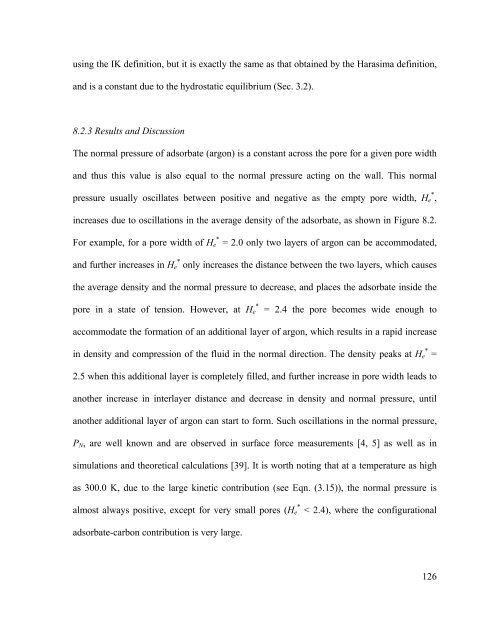ABSTRACT LONG, YUN. Pressure Tensor of Adsorbate in ...
ABSTRACT LONG, YUN. Pressure Tensor of Adsorbate in ...
ABSTRACT LONG, YUN. Pressure Tensor of Adsorbate in ...
Create successful ePaper yourself
Turn your PDF publications into a flip-book with our unique Google optimized e-Paper software.
us<strong>in</strong>g the IK def<strong>in</strong>ition, but it is exactly the same as that obta<strong>in</strong>ed by the Harasima def<strong>in</strong>ition,<br />
and is a constant due to the hydrostatic equilibrium (Sec. 3.2).<br />
8.2.3 Results and Discussion<br />
The normal pressure <strong>of</strong> adsorbate (argon) is a constant across the pore for a given pore width<br />
and thus this value is also equal to the normal pressure act<strong>in</strong>g on the wall. This normal<br />
pressure usually oscillates between positive and negative as the empty pore width, H * e ,<br />
<strong>in</strong>creases due to oscillations <strong>in</strong> the average density <strong>of</strong> the adsorbate, as shown <strong>in</strong> Figure 8.2.<br />
For example, for a pore width <strong>of</strong> H * e = 2.0 only two layers <strong>of</strong> argon can be accommodated,<br />
and further <strong>in</strong>creases <strong>in</strong> H * e only <strong>in</strong>creases the distance between the two layers, which causes<br />
the average density and the normal pressure to decrease, and places the adsorbate <strong>in</strong>side the<br />
pore <strong>in</strong> a state <strong>of</strong> tension. However, at H e *<br />
= 2.4 the pore becomes wide enough to<br />
accommodate the formation <strong>of</strong> an additional layer <strong>of</strong> argon, which results <strong>in</strong> a rapid <strong>in</strong>crease<br />
<strong>in</strong> density and compression <strong>of</strong> the fluid <strong>in</strong> the normal direction. The density peaks at H * e =<br />
2.5 when this additional layer is completely filled, and further <strong>in</strong>crease <strong>in</strong> pore width leads to<br />
another <strong>in</strong>crease <strong>in</strong> <strong>in</strong>terlayer distance and decrease <strong>in</strong> density and normal pressure, until<br />
another additional layer <strong>of</strong> argon can start to form. Such oscillations <strong>in</strong> the normal pressure,<br />
P N , are well known and are observed <strong>in</strong> surface force measurements [4, 5] as well as <strong>in</strong><br />
simulations and theoretical calculations [39]. It is worth not<strong>in</strong>g that at a temperature as high<br />
as 300.0 K, due to the large k<strong>in</strong>etic contribution (see Eqn. (3.15)), the normal pressure is<br />
almost always positive, except for very small pores (H * e < 2.4), where the configurational<br />
adsorbate-carbon contribution is very large.<br />
126
















